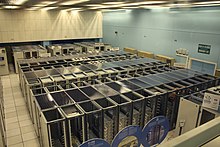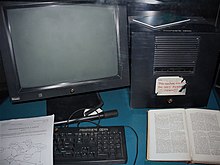In March 1989, Tim Berners-Lee wrote a proposal[6] that referenced ENQUIRE, a database and software project he had built in 1980, and described a more elaborate information management system.
With help from Robert Cailliau, he published a more formal proposal (on November 12, 1990) to build a "Hypertext project" called "WorldWideWeb" (one word, also "W3") as a "web" of "hypertext documents" to be viewed by "browsers" using a client–server architecture.[2] This proposal estimated that a read-only web would be developed within three months and that it would take six months to achieve "the creation of new links and new material by readers, [so that] authorship becomes universal" as well as "the automatic notification of a reader when new material of interest to him/her has become available." See Web 2.0 and RSS/Atom, which have taken a little longer to mature.
The proposal had been modeled after the Dynatext SGML reader by Electronic Book Technology, a spin-off from the Institute for Research in Information and Scholarship at Brown University. The Dynatext system, licensed by CERN, was technically advanced and was a key player in the extension of SGML ISO 8879:1986 to Hypermedia within HyTime, but it was considered too expensive and had an inappropriate licensing policy for use in the general high energy physics community, namely a fee for each document and each document alteration.

The CERN datacenter in 2010 housing some www servers.
The crucial underlying concept of hypertext originated with older projects from the 1960s, such as the Hypertext Editing System (HES) at Brown University, Ted Nelson's Project Xanadu, and Douglas Engelbart's oN-Line System (NLS). Both Nelson and Engelbart were in turn inspired by Vannevar Bush's microfilm-based "memex", which was described in the 1945 essay "As We May Think".[citation needed]
Berners-Lee's breakthrough was to marry hypertext to the Internet. In his book Weaving The Web, he explains that he had repeatedly suggested that a marriage between the two technologies was possible to members of both technical communities, but when no one took up his invitation, he finally tackled the project himself. In the process, he developed a system of globally unique identifiers for resources on the Web and elsewhere: the Universal Document Identifier (UDI), later known as Uniform Resource Locator (URL) and Uniform Resource Identifier (URI); the publishing language HyperText Markup Language (HTML); and the Hypertext Transfer Protocol (HTTP).[14]
The World Wide Web had a number of differences from other hypertext systems that were then available. The Web required only unidirectional links rather than bidirectional ones. This made it possible for someone to link to another resource without action by the owner of that resource. It also significantly reduced the difficulty of implementing web servers and browsers (in comparison to earlier systems), but in turn presented the chronic problem of link rot. Unlike predecessors such as HyperCard, the World Wide Web was non-proprietary, making it possible to develop servers and clients independently and to add extensions without licensing restrictions. On April 30, 1993, CERN announced[15] that the World Wide Web would be free to anyone, with no fees due. Coming two months after the announcement that the Gopher protocol was no longer free to use, this produced a rapid shift away from Gopher and towards the Web. An early popular web browser was ViolaWWW, which was based upon HyperCard.
Scholars generally agree that a turning point for the World Wide Web began with the introduction[16] of the Mosaic web browser[17] in 1993, a graphical browser developed by a team at the National Center for Supercomputing Applications at the University of Illinois at Urbana-Champaign (NCSA-UIUC), led by Marc Andreessen. Funding for Mosaic came from the U.S. High-Performance Computing and Communications Initiative, a funding program initiated by the High Performance Computing and Communication Act of 1991, one of several computing developments initiated by U.S. Senator Al Gore.[18] Prior to the release of Mosaic, graphics were not commonly mixed with text in web pages and the Web's popularity was less than older protocols in use over the Internet, such as Gopher and Wide Area Information Servers (WAIS). Mosaic's graphical user interface allowed the Web to become, by far, the most popular Internet protocol.
The World Wide Web Consortium (W3C) was founded by Tim Berners-Lee after he left the European Organization for Nuclear Research (CERN) in October, 1994. It was founded at the Massachusetts Institute of Technology Laboratory for Computer Science (MIT/LCS) with support from the Defense Advanced Research Projects Agency (DARPA), which had pioneered the Internet; a year later, a second site was founded at INRIA (a French national computer research lab) with support from the European Commission DG InfSo; and in 1996, a third continental site was created in Japan at Keio University. By the end of 1994, while the total number of websites was still minute compared to present standards, quite a number of notable websites were already active, many of which are the precursors or inspiration for today's most popular services.
Connected by the existing Internet, other websites were created around the world, adding international standards for domain names and HTML. Since then, Berners-Lee has played an active role in guiding the development of web standards (such as the markup languages in which web pages are composed), and in recent years has advocated his vision of a Semantic Web. The World Wide Web enabled the spread of information over the Internet through an easy-to-use and flexible format. It thus played an important role in popularizing use of the Internet.[19] Although the two terms are sometimes conflated in popular use, World Wide Web is not synonymous with Internet.[20] The Web is an application built on top of the Internet.

Tidak ada komentar:
Posting Komentar